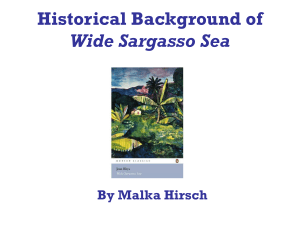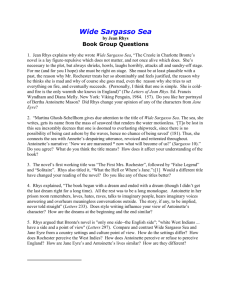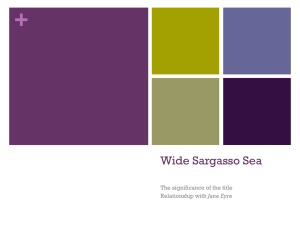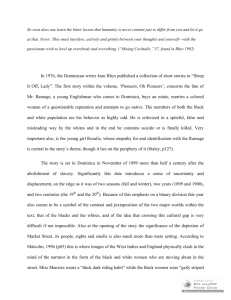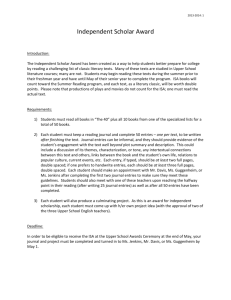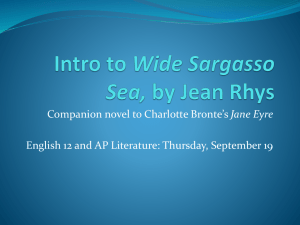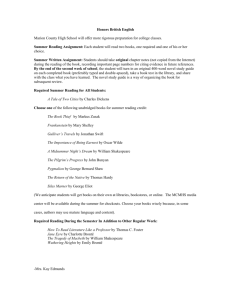Notes on the Sublime Experience in Jean Rhys's Wide Sargasso Sea
advertisement
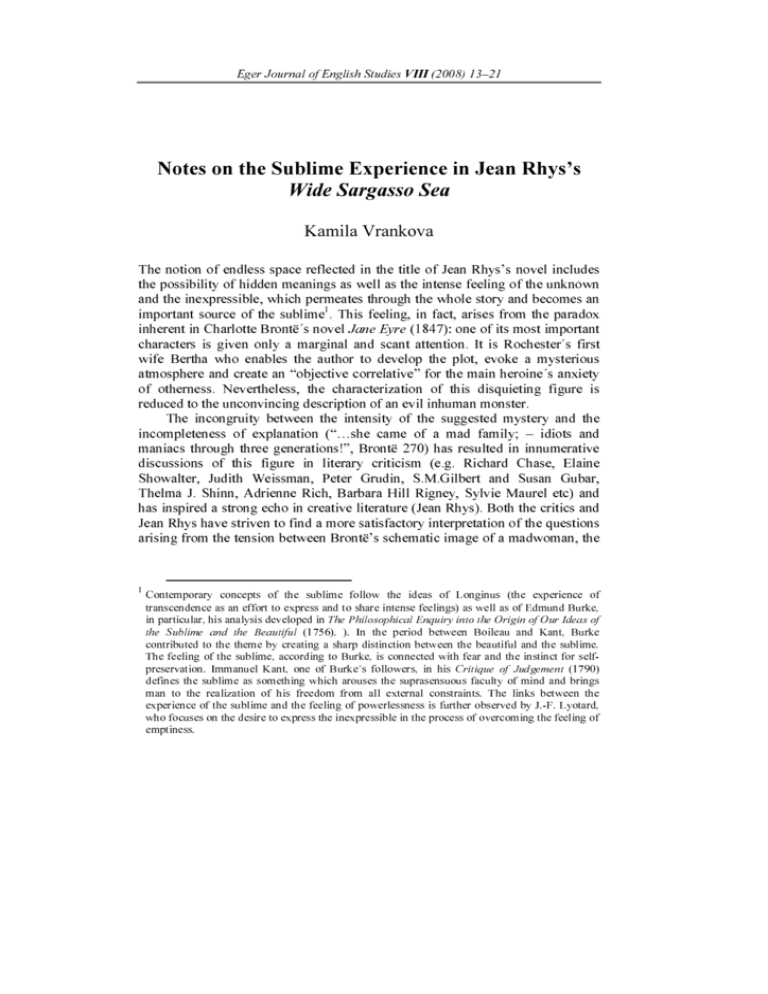
Eger Journal of English Studies VIII (2008) 13–21 Notes on the Sublime Experience in Jean Rhys’s Wide Sargasso Sea Kamila Vrankova The notion of endless space reflected in the title of Jean Rhys’s novel includes the possibility of hidden meanings as well as the intense feeling of the unknown and the inexpressible, which permeates through the whole story and becomes an important source of the sublime1. This feeling, in fact, arises from the paradox inherent in Charlotte Brontë´s novel (1847): one of its most important characters is given only a marginal and scant attention. It is Rochester´s first wife Bertha who enables the author to develop the plot, evoke a mysterious atmosphere and create an “objective correlative” for the main heroine´s anxiety of otherness. Nevertheless, the characterization of this disquieting figure is reduced to the unconvincing description of an evil inhuman monster. The incongruity between the intensity of the suggested mystery and the incompleteness of explanation (“…she came of a mad family; – idiots and maniacs through three generations!”, Brontë 270) has resulted in innumerative discussions of this figure in literary criticism (e.g. Richard Chase, Elaine Showalter, Judith Weissman, Peter Grudin, S.M.Gilbert and Susan Gubar, Thelma J. Shinn, Adrienne Rich, Barbara Hill Rigney, Sylvie Maurel etc) and has inspired a strong echo in creative literature (Jean Rhys). Both the critics and Jean Rhys have striven to find a more satisfactory interpretation of the questions arising from the tension between Brontë’s schematic image of a madwoman, the Jane Eyre 1 Contemporary concepts of the sublime follow the ideas of Longinus (the experience of transcendence as an effort to express and to share intense feelings) as well as of Edmund Burke, in particular, his analysis developed in The Philosophical Enquiry into the Origin of Our Ideas of the Sublime and the Beautiful (1756). ). In the period between Boileau and Kant, Burke contributed to the theme by creating a sharp distinction between the beautiful and the sublime. The feeling of the sublime, according to Burke, is connected with fear and the instinct for selfpreservation. Immanuel Kant, one of Burke´s followers, in his Critique of Judgement (1790) defines the sublime as something which arouses the suprasensuous faculty of mind and brings man to the realization of his freedom from all external constraints. The links between the experience of the sublime and the feeling of powerlessness is further observed by J.-F. Lyotard, who focuses on the desire to express the inexpressible in the process of overcoming the feeling of emptiness. 14 Kamila Vrankova role of an imprisoned wife in the Gothic novel and a suggestive demand for freedom and justice as voiced by Bertha’s counterpart, Jane Eyre. According to her own words, Jean Rhys was vexed at Brontë´s portrait of “the ´paper tiger´ lunatic, fighting mad to tell” Bertha´s story (Rhys 1984: 262). Brontë´s silent prisoner, whose opportunity for self expression is suppressed by the inability to master language, is given a voice by Jean Rhys. The “off stage” protagonist is taken “on stage” (Rhys 1984: 156). Drawing on her own experience of the West Indies, Jean Rhys shows the fate of a young, unhappily married Creole heiress in a wider context of cultural differences, colonial conflicts and racial hatred. Born in Dominica as the daughter of a Welsh doctor and a white Creole mother, Jean Rhys came to England at the age of sixteen. Like her heroine, she had to undergo a complicated search for identity and Antoinette´s story reflects her own sense of alienation and displacement. When Charlotte Brontë´s Rochester tries to explain his inability to comprehend the manners of his wife Bertha, he describes her tempestuous nature against the background of a stormy West Indian landscape: The air was like sulphur-steams […] Mosquitoes came buzzing in […]; the sea […] rumbled dull like an earthquake – black clouds were casting up over it; the moon was […] broad and red, like a hot cannonball […] (Brontë 271) According to Rochester, it is the exotic origin and Creole blood that causes Bertha´s lunacy and, accordingly, her propensity towards sin and crime. The emotional intensity connected with the feeling of the sublime is linked to “unconscious fears and desires projected on to other culture, peoples and places” (Botting 154) and insanity is viewed in terms of racial prejudice. To emphasize the virtues of his beloved bride Jane, he finds it necessary to point out her English origin: “I would not exchange this one little English girl for the grand Turk´s whole seraglio; gazelle-eyes, houri forms and all!” (Brontë 301). In such remarks we can observe touches of what becomes obvious at the end of Brontë´s novel. The dark and mysterious distance-driven hero, seeming to embody Gothic and Romantic passions, undergoes the process of “domestication” and, following Jane´s example, turns into a defender of self-control, moderation and order.2 It is the fate of Bertha that continues to evoke a gloomy, subliminal atmosphere. Her story of an imprisoned wife draws on the Gothic theme of 2 See Virgil Nemoianu´s Taming of Romanticism (Harvard University Press, 1984), a study of the English literary scene after 1815, in particular of “the tendency to turn romanticism into something both social and intimate, both practical and domestic, while preserving – to whatever extent – the original vision (48). He discusses the way how the motif of the Romantic hero is developed in the 19th-century English literature. Notes on the Sublime Experience in Jean Rhys’s Wide Sargasso Sea 15 victimhood, developed, for example, by Horace Walpole in his Castle of Otranto or by Anne Radcliffe in Sicilian Romance. At the same time, her function in Brontë´s novel, like the function of Gothic villains (e.g. of M.G.Lewis´s Monk), is to represent the character of the other, of an estranged and weird being whose presence challenges the moral consciousness of other protagonists, violates their conception of goodness, unity and coherence and turns the narrative into a tale of Gothic horror. Her final removal from the novel allows the author to resort to the idyllic model and “superimpose it upon romantic aspirations" (Nemoianu 60). However, despite the calm and conciliatory mood of the conclusion, the Gothic undertones remain disturbingly vivid and burst out with a new intensity in the story of Wide Sargasso Sea. In Jean Rhys´s novel, the conflict between European and West Indian consciousness is worked out through the same fatal relationship but from various points of view. As in Jane Eyre, on a surface level it is a conflict between conventional attitudes and emotional excesses. In contrast to Jane Eyre, it becomes the crucial subject of the narrative and its psychological, social, historical and geographical aspects are employed without suppressing the effects of the irrational and the mysterious. The “projective method” of landscape description, which is an important device of characterization in the novel, contributes to the escalation of the conflict. Contrary to the wintry landscapes forming the setting of Jane Eyre, the summery clime of the West Indies in Wide Sargasso Sea is typical of Romantic topography and evokes the space of the traditional Gothic romance. The heroes´ response to the surrounding environment reveals much of their own nature: Antoinette´s (Bertha´s) love of the Carribean landscape corresponds with her passionate emotions, while Rochester´s sobriety reflects his fear of passion and a dependence on the security of the civilized world. Moreover, the heroes´ changing attitudes to particular places reflect the development of their mutual relationship, especially the shift from confidence and identification (“This is my place and everything is on our side”; Rhys 62) to estrangement: ´I feel very much a stranger here´, I said. ´I feel that this place is my enemy and on your side´. ´You are quite mistaken [… ] It is not for you and not for me. It has nothing to do with either of us. That is why you are afraid of it, because it is something else […]´ (Rhys 107) This feeling of uneasiness, which originates in experiencing a particular environment as something else, results in the tragic inability to accept the other: the other landscape, the other culture and the other individual. 16 Kamila Vrankova ´Is it true … that England is like a dream?´ … ´Well … that is precisely how your beautiful island seems to me, quite unreal and like a dream´. (Rhys 67) The physical and spiritual distance between the worlds of England and the West Indies and, implicitly, the unfulfilled desire and the failure of communication between the two main protagonists is implied by the image of the sea, suggesting a notion of vastness and emptiness.3. Moreover, the motif of the sea is put into a close connection with the nightmarish atmosphere and becomes a metaphor for the mystery and the hidden threat (the sargassos) that are foregrounded in the plot of Jean Rhys´s (as well as Charlotte Brontë´s) novel. It is a symbolic space where the external reality mingles with the reality of an internal world and where the deepest desires and anxieties of the soul are mirrored:4 “When I woke it was a different sea. Colder. It was that night, I think, that we changed course and lost our way to England” (Rhys 148). Thus the image of sea is used to approximate the mental state of the heroine and the theme of hidden irrational and subconscious forces reappears in many crucial scenes, eg in the description of a bathing pool with flowers on the surface and the “monster crab” (Rhys 73) in its depths. The atmosphere of hostility is intensified by the images of the forest (“I found that the undergrowth and creepers caught at my legs and the trees closed over my head”; Rhys 87), and “an alien moon” (Rhys 74). Rochester´s anxiety seems to spring from his awareness of the uncontrollable powers of nature which force their way into the civilized world and threaten to conquer it. It is the same fear of the unknown and the invisible that makes him distrust his beautiful exotic wife (“she was a stranger to me, a stranger who did not think or feel as I did…” (Rhys 78) and leads him to the denial of her right for an equal, independent existence (“She was only a ghost. A ghost in the grey daylight …”; Rhys 140). The image of the forest concealing a sinister stranger appears in recurring dreamy visions of the heroine: “It is still night and I am walking towards the forest […] We are under the tall dark trees and there is no wind” (Rhys 50). As Anthony Luengo puts it, “the dense tropical forest“, symbolizing “the increasing 3 For Burke, the “greatness of dimension” is one of the most powerful sources of the sublime, while the image of human weakness is presented in contrast with the power of natural and supernatural forces. Immanuel Kant, one of Burke´s followers, in his Critique of Judgement (1790) defines the sublime as something which arouses the suprasensuous faculty of mind and brings man to the realization of his freedom from all external constraints. 4 In the first chapter of Moby Dick, the image of sea (and of watery surfaces in general) is discussed with respect to its influence on human psyche. Melville gathers numerous mythological and literary sources considering water an enigmatic space where a key to the mystery of human identity is hidden. Gothic and Romantic fiction are both particularly concerned with this attitude and employs the motif of sea for its symbolic connotations, which is also the method of Rhys´s novel. Notes on the Sublime Experience in Jean Rhys’s 17 Wide Sargasso Sea gloom and confusion” of Antoinette´s and Rochester´s mind should be seen as “a latter-day descendent of the many dark woods that appear in the novel´s late eighteenth and early nineteenth-century literary ancestors” (Luengo 167). While in the disquieting notion of gloominess and danger is, in accordance with the tradition of the English Gothic novel, centred around an ancient house and its secret chamber, the impressive descriptions of the forest in reflect the influence of neo-Gothic fiction, especially as it developed in America.5 Among the significant attributes of Antoinette´s dreams is the subliminal effect of silence, darkness and loneliness. The fear of the other person (who gradually appears to embody Rochester) is communicated through the reference to his face “blank with hatred” (Rhys 50). Almost the same words are used by Rochester describing Antoinette´s “blank hating moonstruck face” (Rhys 136). Thus, the repeated images of a “blank face” turn into a synonym of ultimate isolation, the loss of human touch and a terrifying nothingness permeating and destroying the relationship. The link between the motif of a stranger and the motif of a ghost is completed. The spectral images permeate the heroine´s view of herself: “I went into the hall with the tall candle in my hand. It was then that I saw her – the ghost. The woman with streaming hair. She was surrounded by a guilt frame but I knew her (Rhys 154) and suggest the notion of an othered self, which is reflected also on the level of grammar (the use of the pronoun her). The mention of a gilt frame suggests the image of a looking glass, which, as in or , accompanies the theme of the divided personality. A similar experience is described in the following recollection: Jane Eyre Wide Sargasso Sea ” Jane Eyre Wuthering Heights There is no looking-glass here and I don´t know what I am like now. I remember watching myself brush my hair and how my eyes looked back at me. The girl I saw was myself yet not quite myself. Long ago when I was a child and very lonely I tried to kiss her. But the glass was between us – hard, cold and misted over with my breath. (Rhys 147) What Rochester may call vanity (“She´ll not dress up and smile at herself in that damnable looking-glass … vain, silly creature;” Rhys 136) is rather an expression of Antoinette´s “impossible desire for self-completion” (Howells 115). According to Helen Tiffin, Antoinette, as well as Jean Rhys´s other heroines, is “obsessed by mirrors and the need for outside opinion” (Tiffin 329), which determines her sense of identity and self-worth. It is this dependence that 5 The development of American Gothic fiction is discussed in Leslie Fiedler´s Love and Death in American Novel (New York: Stein and Day, 1966). According to this study, “the haunting forest provided a handy solution to a basic problem that faced the Gothic in the New World: what to substitute for the centuries-old castle of the European Gothic writers?” 18 Kamila Vrankova predestines her to the position of a mad person: her supposed madness is discussed by the people around her (hateful neighbours and relatives) long before her conflict with Rochester begins. It also predestines her to the victimized, ghost-like position, mentioned above: “Someone screamed and I thought, Why did I scream?” (Rhys 155). In another context, the word ‘ghosts’ is used instead of the word ‘rumours’ and reflects Rochester´s transitory recognition of the fatal consequences of hatred and envy: “We are letting ghosts trouble us. Why shouldn´t we be happy?” (Rhys 113). Jean Rhys, transforming conventional machinery of the so called “terror Gothic”, manages to exploit the supernatural element as an inseparable part of the characterization and setting. Moreover, she chooses a number of Ghost motifs to suggest the power of a hidden, subversive life undermining existing social and psychological orders. Her ghosts, exciting and increasing the disruptive atmosphere of the novel, are rather mental phenomena, the expressions of anguish of the main characters. In Wide Sargasso Sea, the feeling of the sublime is increased by the motifs of houses, which, as in Jane Eyre or Wuthering Heights, function as organizing symbols for the novel. Thus Part One is connected with the country house Coulibri, the honeymoon cottage Granbois, “a very wild, cool and remote place” (Rhys 57,64), creates the setting for the Part Two, and the final incidents take place in Charlotte Brontë´s Thornfield. According to Elaine Campbell, Rhys´s portrait of Coulibri is primarily a Gothic device but at the same time it gains in importance because of its sociohistoric context. She considers Coulibri as the double for Brontë´s Thornfield: “…it is an almost cynical doubling for Rhys to see Antoinette´s burning of Thornfield Hall as a double exposure of the freed slaves´ burning of Coulibri” (Campbell 313). In the destruction of Coulibri Jean Rhys reverts to the Gothic mode through the theme of ruins, symbolizing the end of the aristocratic authority that the building was to represent. The repeated employment of ruins in Wide Sargasso Sea can be also seen in terms of “a romantic statement of deeper, more universal significance of the kind made by Radcliffe” (Luengo 167). The ruins represent both the world of the past and the world of the sacred, as the place, suggesting the notion of a religious cult and magic rituals, has all attributes of a pagan temple. This circumstance helps to create a tension between the “civilized” (Rochester´s Christianity) and the “wild” (the natural religion of the West Indies), which is impressively employed also in Wuthering Heights. Jean Rhys´s novel opens with the Gothic image of a haunted interior: “Mr Luttrel´s house was left empty, shutters banging in the wind. Soon the black people said it was haunted, they wouldn´t go near it.” (Rhys 15) As in the traditional Gothic tales, this motif is connected with a mysterious incident (the disappearance of the owner) and with reference to the haunted past permeating Notes on the Sublime Experience in Jean Rhys’s Wide Sargasso Sea 19 the house. In Wide Sargasso Sea, however, the author does not indulge in describing fantastic crimes and demonic villains. Instead, she makes her haunted house an emblem of the historical consequences of slavery and racial confrontation in British colonies. The plot of Wide Sargasso Sea revolves around the Gothic theme of an imprisoned wife. Though the crucial motifs concerned with the imprisonment (as well as with the model story of Charlotte Brontë) appear in Part Three, from the very first sentence of the novel there is a number of hints suggesting the reality of exclusion and restriction: “They say when trouble comes close ranks … But we were not in their ranks.” (Rhys 15) The heroine is introduced as an orphaned daughter of a West Indian plantation owner, whose family was impoverished by the liberation of the slaves after the Emancipation Act in the early nineteenth century. But emancipation for some means bondage for others. The heroine´s widowed mother is trapped in isolation, belonging neither to the black community nor to the dominant class. Accordingly, Antoinette becomes a double outsider: “white nigger” for the Europeans and “white cockroach” for the Blacks. Having experienced the tragic consequences of wild, irrational hatred (the death of her brother Pierre and her mother, the loss of home), young Antoinette turns to a nun: “Such terrible things happen … Why?” The answer is, as in all other cases, suspended: “We do not know why the devil must have his little day. Not yet.” (Rhys 51).The mystery of evil, in Gothic tales usually associated with the figure of a villain, is further complicated in Wide Sargasso Sea. Jean Rhys connects it with thoughts and deeds of ordinary people. Even Rochester, fatally wounding the heroine, is considered as “not the best, not the worst”. The violence marking mutual relationships in the novel often seems to be motivated (as in Coleridge´s Rime of the Ancient Mariner or in Golding´s Lord of the Flies) quite irrationally: “´They (black neighbours) are children – they wouldn´t hurt a fly.´ ´Unhappily children do hurt flies,´said Aunt Cora” (Rhys 30). The nun´s words “not yet” contain, however, a promise of the answer. It seems to be hidden behind the lines of Daniel Cosway´s letter: “they are white, I am coloured. They are rich, I am poor … of all his (Antoinette´s father´s) illegitimates I am the most unfortunate and poverty stricken” (Rhys 81). It is the concern with money and possessions that leads Tia to betray Antoinette. It kindles the hate of the black neighbours and makes Rochester marry an unloved woman. Even Amélie´s betrayal and Grace Poole´s silent approval of the Thornfield crime are bound up with money. Finally, Antoinette´s complete dependence on her husband and, consequently, her ruin, is sealed by the fact that after the marriage her fortune is taken by Rochester. Critics detected similarities between Antoinette´s fate and that of black slaves in the West Indian world. According to Helen Tiffin, “in the marriage between Antoinette Cosway and Rochester, the imperial/colonial relation is 20 Kamila Vrankova clear” (Tiffin 338). As C.A. Howells puts it, “the drama of Rhys´s novel is the drama of West Indian history focused through the figure of the mad wife in Jane Eyre” (Howells 107). The money initiates Rochester´s metamorphosis in the direction of the Gothic villain. Being introduced as a romantic suitor reminding us of the gentle young heroes as Walpole´s Theodore or Radcliffe´s Valancourt, he quickly turns into a Faust-like figure: “I have sold my soul or you have sold it, and after all is it such a bad bargain?” (Rhys 59). The fatal role of money in Antoinette´s life is repeatedly suggested throughout the novel and the recognition of its power is voiced in Part III, where the mad heroine is, in fact, the only person capable of understanding the reality of Thornfield: “Gold is the idol they worship” (WSS, 154). To sum it up, in Wide Sargasso Sea the Gothic theme of otherness is worked out through the conflict between European and West Indian consciousness. Responding to Charlotte Brontë´s description of insanity in terms of racial prejudice (in Jane Eyre, Bertha´s lunacy originates in her exotic origin and Creole blood), Jean Rhys offers a reconstruction of causality and shows that it is racial prejudice that violates order and eventually drives the heroine to madness. Moreover, the sin of greed and dependence on luxury (in Jane Eyre embodied by Bertha) is connected rather with the cultured Christian society. Thus the traditional motifs of horror fiction (ghosts, nightmares, haunted places, dark forests, ruins or boundless ocean horizons…) are incorporated into a complex, inward account of alienation and misunderstanding. The notion of the sublime arises less from the conflict between the moral order and an evil influence than from the tension between the familiar and the other, and from the difficulty to cope with the reality of cultural, religious but also individual differences. References Botting, Fred. Gothic. London: Routledge, 1996 Brontë, Charlotte. Jane Eyre. 1847. Ed. Mary Ibbett. London: Wordsworth Classics, 1992 Campbell, Elaine. “A Report from Dominica, B.W.I.”, World Literature Written in English. Arlington: The University of Texas at Arlington, 1978 Howells, C.A.. Jean Rhys. New York: St. Martin Press, 1991 Luengo, Anthony. “Wide Sargasso Sea and the Gothic Mode.” Critical Perspectives on Jean Rhys, ed. P.M. Frickey. New York: Three Continents Press, 1990 Nemoianu, Virgil. Taming of Romanticism. Harvard University Press, 1984 Rhys, Jean. Letters 1931-1966. London: Andre Deutsch, 1984 ---. Wide Sargasso Sea. (1966) Ed. Francis Wyndham. London: Penguin Books, 1968 Notes on the Sublime Experience in Jean Rhys’s Wide Sargasso Sea 21 Tiffin, Helen. “Mirror and Mask: Colonial motifs in the novels of Jean Rhys”, World Literature Written in English. Arlington: The University of Texas at Arlington, 1978
